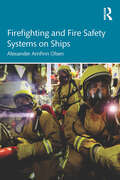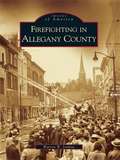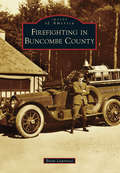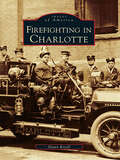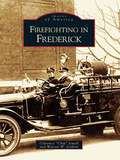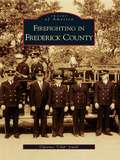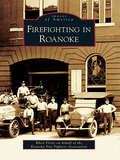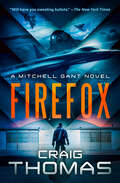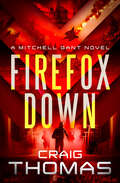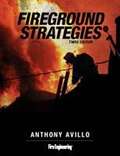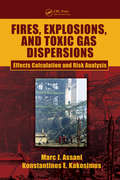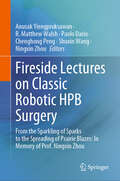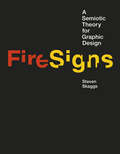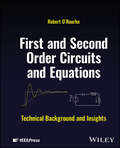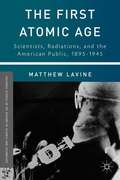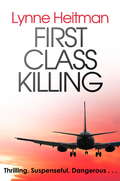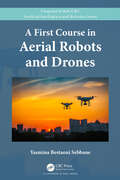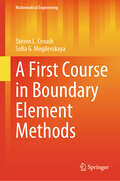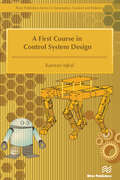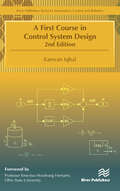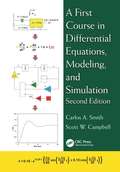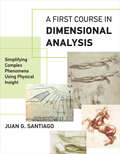- Table View
- List View
Firefighting and Fire Safety Systems on Ships
by Alexander Arnfinn OlsenThis accessible reference introduces firefighting and fire safety systems on ships and is written in line with the IACS Classification Rules for Firefighting Systems. It covers the design, construction, use and maintenance of firefighting and fire safety systems, with cross references to the American Bureau of Shipping rules and various Classification Society regulations which pertain to specific Classification Society rules. Focuses on basic principles in line with current practice Aimed at non-specialists The book suits professional seafarers, students, and cadets, as well as leisure sailors and professionals involved in the logistics industry. It is also particularly useful for naval architects, ship designers, and engineers who need to interpret the Class rules when developing shipboard firefighting systems.
Firefighting in Allegany County (Images of America)
by Warren W. JenkinsFirefighting in mountainous Allegany County has evolved from bucket brigades and hose reels to a paid fire department in the county seat of Cumberland and 23 modern volunteer fire departments. Highlighted in Firefighting in Allegany County is the Cumberland Fire Department, which formed in 1906 as the second paid fire department in Maryland. The oldest all-volunteer department, Frostburg, is also given extensive coverage as well as the volunteer fire companies in the coal-mining region of Georges Creek. The more rural area of eastern Allegany County and suburban Cumberland have been protected by volunteer fire companies since the 1930s and 1940s.
Firefighting in Buncombe County (Images of America)
by Brian LawrenceWhen Buncombe County was formed in 1792, firefighting efforts were left up to individual landowners and helpful neighbors using buckets and a nearby well or body of water. Not until 1882 was an organized, community-sponsored fire department established; this was the Asheville Fire Department. Other fire departments followed, and no two were the same. Stations appeared in the towns of Weaverville and Black Mountain, while others sprang up in the residential communities of Kenilworth, Biltmore Forest, and George Vanderbilt's Biltmore Village. In September 1953, county commissioners formally passed a resolution for county aid and supervision for rural volunteer fire departments. Through photographs that illustrate firefighting in many of its forms--rescue squads, wildland firefighting units, ladies auxiliaries, and ambulance services--Firefighting in Buncombe County showcases and honors the firefighters of this mountainous area who have always worked to keep their communities safe.
Firefighting in Charlotte (Images of America)
by Shawn RoyallThe story of firefighting in Charlotte is a tale of explosive growth and change that dates back to its humble beginnings in 1887. The city of Charlotte credits expansion to several events, including the gold rush of the 1830s, the railroad expansion of the 1860s, and the textile boom of the 1880s. During the textile boom, the volunteer firefighters protecting Charlotte and Mecklenburg County could no longer adequately protect the growing city. Thus the Charlotte Fire Department was born. The Roaring Twenties brought in the auto age and along with it motorized fire trucks. Race tensions of the 1960s and the financial boom of the 1990s also figure in the fire department's history. Returning to her roots of growth, Charlotte is now a bustling financial and transportation hub of 650,000 residents protected by more than 1,000 firefighters living in 38 firehouses. Firefighting in Charlotte provides a photographic road map of how fire protectiondeveloped from horse-drawn engines of the 1800s to the state-of-the-art apparatus of today. Fire trucks, firehouses, and the firefighters are depicted in images obtained from personal collections, newspapers, archives, and museums.
Firefighting in Frederick (Images of America)
by Clarence Chip" Jewell Warren W. JenkinsThe story of firefighting in Frederick, Maryland, is a complex tale of heroism, sacrifice, and duty that dates back to 1818. This volume describes the vital role the fire department has played in defending the city for close to two centuries. Highlighted in this work are the Independent Hose Company, Junior Fire Company, United Steam Fire Engine Company, Citizen's Truck Company, Fort Detrick Fire Department, key fires, emergency medical services, and major disasters throughout the region.
Firefighting in Frederick County (Images of America)
by Clarence Chip" JewellImages of America: Firefighting in Frederick County honors the contribution of both volunteer and career firefighters through the years. Captured in these 200 vintage images are the local volunteer fire companies, many support agencies, and other emergency services organizations that have been assisting Frederick County for centuries. Featured also will be photographs of the Independent Hose Company of Frederick, which has the honor of being the oldest continuously operating fire company in Maryland, having been founded in 1818. Today, Frederick County is home to the National Fire Academy and the National Fallen Firefighters Memorial, both located in Emmitsburg and featured in the book.
Firefighting in Roanoke (Images of America)
by Roanoke Fire Fighters Association Rhett FleitzThe Roanoke Fire Department's history began in 1882 when the first firefighters were organized by the newly chartered City of Roanoke. The volunteer fire companies such as the Vigilants, Juniors, Friendship, and Alerts provided protection against fire for the city. Roanoke began paying firefighters in about 1903; they were usually drivers to get the horses and steam engines ready for when the volunteers showed up. In 1907, the last of the volunteers disbanded in a show of solidarity to the city, and the Roanoke Fire Department became fully paid. The department doubled in size in 1936 when a second platoon was added and grew again in 1972 when the third platoon was added. The Roanoke Fire Department continued to protect the citizens and visitors of Roanoke City up until 1995 when it merged with Roanoke City EMS to form the Roanoke Fire-EMS Department. In Firefighting in Roanoke, the history of this 125-year-old local service tradition is told.
Firefox (The Mitchell Gant Series)
by Craig ThomasThe New York Times–bestselling Cold War thriller: It&’s the most advanced stealth fighter ever developed, and his job is to steal it from the Soviets . . . The Soviets have created a new plane equipped with a weapons system that can be activated via sensors in the pilot&’s helmet—an advance that could shift the global balance of power. But British intelligence has a plan. There are two prototypes within the heavily secured Soviet base, and with some help from the CIA, they&’re going to steal one. The man chosen for the job is US pilot and troubled Vietnam veteran Mitchell Gant. First, he has to get into Russia. Then the airbase. Then the hangar. Then onto the plane and into the air. All while the KGB scrambles to stop him at any cost . . . &“Like a domino fall in slow motion.&” —Kirkus Reviews (starred review) &“Will have you sweating bullets. Thomas misses no tricks, and tension is sustained from first page to last.&” —The New York Times Book Review
Firefox Down! (The Mitchell Gant Series)
by Craig ThomasNew York Times Bestseller: The follow-up to the classic Cold War thriller continues the story of spies, stealth technology, and survival . . . The plan was to steal the Soviet Union&’s prototype for the world&’s most advanced stealth fighter from under their noses. What could go wrong? A lot, it turns out. A crash landing in remote, frigid Finland leaves daredevil pilot Mitchell Gant fighting for survival and trying to elude his pursuers. Meanwhile, the US and UK desperately calculate their chances of recovering the plane—and getting out of the area before the Russians arrive. They&’ve made it this far, but will their efforts come to nothing in the end? &“Lively, straightforward action.&” —Kirkus Reviews (starred review) &“The last word in espionage thrillers.&” —The Pittsburgh Press
Fireground Strategies
by Anthony AvilloA 30-year veteran of the fire service, Chief Avillo has updated his widely adopted book, Fireground Strategies. The new third edition of Fireground Strategies is written from the viewpoint of the fire officer who must identify a strategy, develop an action plan, and implement tactics to meet that plan's objectives. Used together, Fireground Strategies and the Scenarios Workbook provide reinforcing guides for assuming a role on the fireground and making decisions aimed at bringing the incident to a safe and successful conclusion. The new third edition includes expanded incident command chapters, new street-level strategies focusing on the modern fire environment, the latest attack/ventilation study information, expanded resource management and risk management sections, strategic considerations of solar panels, new case studies, and more!
Fires, Explosions, and Toxic Gas Dispersions: Effects Calculation and Risk Analysis
by Marc J. Assael Konstantinos E. KakosimosToday's risk analysis is a very challenging field, and a solid understanding of the calculations procedure associated with it is essential for anyone involved. Fires, Explosions, and Toxic Gas Dispersions: Effects Calculation and Risk Analysis provides an overview of the methods used to assess the risk of fires, explosions, and toxic gas dispersion
Fireside Lectures on Classic Robotic HPB Surgery: From the Sparkling of Sparks to the Spreading of Prairie Blazes: In Memory of Prof. Ningxin Zhou
by Anusak Yiengpruksawan R. Matthew Walsh Paolo Dario Chenghong Peng Shuxin Wang Ningxin ZhouThis book presents a collection of case reviews on robotic HPB (Hepato-pancreato-biliary) surgeries contributed by distinguished surgical experts and robotics engineers. Each case is accompanied by photographs and discussions to facilitate understanding of the presented projects and techniques. The book not only presents practical robotic HPB surgery techniques, but also offers experts’ reflections and perspectives on the future of robotic surgeries and surgical robotics. Serving as a collection in memory of Prof. Ningxin Zhou, a pioneer of robotic HPB surgery in China, it illustrates the development and success of Prof. Zhou’s study of surgical robotics and his explorations in combining surgery with engineering. The book is a valuable resource for practitioners and researchers in the medical field and engineering alike.
FireSigns: A Semiotic Theory for Graphic Design (Design Thinking, Design Theory)
by Steven SkaggsSemiotics concepts from a design perspective, offering the foundation for a coherent theory of graphic design as well as conceptual tools for practicing designers.Graphic design has been an academic discipline since the post-World War II era, but it has yet to develop a coherent theoretical foundation. Instead, it proceeds through styles, genres, and imitation, drawing on sources that range from the Bauhaus to deconstructionism. In FireSigns, Steven Skaggs offers the foundation for a semiotic theory of graphic design, exploring semiotic concepts from design and studio art perspectives and offering useful conceptual tools for practicing designers.Semiotics is the study of signs and significations; graphic design creates visual signs meant to create a certain effect in the mind (a “FireSign”). Skaggs provides a network of explicit concepts and terminology for a practice that has made implicit use of semiotics without knowing it. He offers an overview of the metaphysics of visual perception and the notion of visual entities, and, drawing on the pragmatic semiotics of the philosopher Charles Sanders Peirce, looks at visual experience as a product of the action of signs. He introduces three conceptual tools for analyzing works of graphic design—semantic profiles, the functional matrix, and the visual gamut—that allow visual “personality types” to emerge and enable a greater understanding of the range of possibilities for visual elements. Finally, he applies these tools to specific analyses of typography.
Fireworks! (Fountas & Pinnell LLI Purple #Level U)
by Paul WinterThe Sound of Celebration. A high-pitched whistle pierces the quiet night, and the spectators hold their breath. Soon a resounding boom will rock the ground beneath their feet, and the sky will light up in a dazzling display of color. For millennia, fireworks have held the world's attention. Discover how an accidental explosion set off a love of fireworks that continues to this day.
Fireworks! Pyrotechnics on Display
by Norman D. Anderson Walter R. BrownFrom the Book Jacket: Bursts of colored lights exploding in the night sky... one spectacular eruption after the other. What could be more glorious than a fireworks display? Whether it is the Fourth of July or some other special occasion, fireworks have been the means of celebrating for hundreds of years in countries all around the world. Come find out about fireworks-what it takes to make them (gunpowder), how they were invented (the Chinese usually get credit), the different kinds (do you know what a gerbe is?), what a fire works factory is like (no synthetic clothing). And the story has to include the disasters caused by fireworks. They are dangerous, and there are laws about the manufacture and sale of them. Tips about photographing fireworks are also offered. About the Authors NORMAN D. ANDERSON is Professor of Science Education at North Carolina State University in Raleigh. WALTER R. BROWN lives in Virginia Beach, Virginia, where he taught junior high school science for several years. Both Dr. Anderson and Dr. Brown received their Ph.D.'s in science education at Ohio State University and they have been writing books together since their graduate student days. They are co authors of a science textbook series that is used in middle and junior high schools throughout the country. They recently collaborated on Halley's Comet, and have done several books in the Historical Catastrophes Series.
Fireworks Tonight!
by Martha BrennerFrom the Book Jacket: Streams of sparks and sprays of colored stars light up the dark sky, thundering blasts echo all around ... FIREWORKS TONIGHT! For centuries man has been playing with fire with dazzling, sometimes dire, results-and few things have as much power to astound and intrigue us. Martha Brenner's research has turned up a wealth of fascinating information on the world of pyrotechnics. She covers the history of fireworks from the primitive firecrackers developed some 2000 years ago in China to the breathtaking special effects of today, the tragic accidents that have led to current laws regulating their use, the intriguing step-by-step development of a modern fireworks show from the drawing board to the actual shooting. How are fireworks made? Very carefully! And almost entirely by hand, because metal machinery produces heat and static electricity that could easily ignite an entire building full of explosives. Who makes fireworks? Most are manufactured by a handful of dynamic, devoted families that have passed on their tricks and trademarks for generations. Fireworks Tonight! gives us profiles of them and their particular pyrotechnical styles. How do fireworks work? Martha Brenner explains that, too-in clear, scientific detail. And there's more. Fireworks Tonight! includes a trip behind the scenes at a fireworks show, a visit to a manufacturing plant, a section on safety, a list of the 50 states' current laws on their sale and use, an illustrated spectators' guide-to help fire works fans tell a roman candle from a rocket and a list of notable fireworks facts: the biggest display in history, the loudest, the longest .. . Generously illustrated with over 60 photo graphs and prints, Fireworks Tonight! is a lively, accurate, and comprehensive introduction to a subject of universal appeal.
First and Second Order Circuits and Equations: Technical Background and Insights
by Robert O'RourkeHelp protect your network with this important reference work on cyber security First and second order electric and electronic circuits contain energy storage elements, capacitors and inductors, fundamental to both time and frequency domain circuit response behavior, including exponential decay, overshoot, ringing, and frequency domain resonance. First and Second Order Circuits and Equations provides an insightful and detailed learning and reference resource for circuit theory and its many perspectives and duals, such as voltage and current, inductance and capacitance, and serial and parallel. Organized and presented to make each information topic immediately accessible, First and Second Order Circuits and Equations offers readers the opportunity to learn circuit theory faster and with greater understanding. First and Second Order Circuits and Equations readers will also find: Root locus charts of second order characteristic equation roots both in terms of damping factor ζ as well as damping constant α. Detailed treatment of quality factor Q and its relationship to bandwidth and damping in both frequency and time domains. Inductor and capacitor branch relationship step response insights in terms of calculus intuition. Derivations of voltage divider and current divider formulae in terms of Kirchhoff’s laws. First and Second Order Circuits and Equations is an essential tool for electronic industry professionals learning circuits on the job, as well as for electrical engineering, mechanical engineering, and physics students learning circuits and their related differential equations.
The First Atomic Age
by Matthew LavineAt the close of the 19th century, strange new forms of energy arrested the American public's attention in ways that no scientific discovery ever had before. This groundbreaking cultural history tells the story of the first nuclear culture, one whose lasting effects would be seen in the familiar "atomic age" of the post-war twentieth century.
First Class Killing: An edge-of-your-seat thriller that will carry you along for the ride (The\alex Shanahan Thrillers Ser. #3)
by Lynne HeitmanA gripping and fast-paced thriller featuring Alex Shanahan - a tough, resourceful private investigator for the aviation world. Perfect for fans of Jeffery Deaver and James Patterson__________When Majestic Airlines gets suspicious that some of its staff are abusing its databases for a rather alarming reason, Alex Shanahan is called in to find out the hard facts.Going undercover as an air-hostess, navigating the gossip and the politics, she soon discovers that a group of her female colleagues are running an 'escort' service for Majestic's customers. Dismissive at first, the closer Alex gets to the cunning and dangerous woman who is running the operation, the more she realises the violence involved. Soon she finds herself investigating murder as well as fraud . . .__________Book 3 in the Alex Shanahan series
A First Course in Aerial Robots and Drones (Chapman & Hall/CRC Artificial Intelligence and Robotics Series)
by Yasmina Bestaoui SebbaneA First Course in Aerial Robots and Drones provides an accessible and student friendly introduction to aerial robots and drones. Drones figure prominently as opportunities for students to learn various aspects of aerospace engineering and design. Drones offer an enticing entry point for STEM studies. As the use of drones in STEM studies grows, there is an emerging generation of drone pilots who are not just good at flying, but experts in specific niches, such as mapping or thermography. Key Features: Focuses on algorithms that are currently used to solve diverse problems. Enables students to solve problems and improve their science skills. Introduces difficult concepts with simple, accessible examples. Suitable for undergraduate students, this textbook provides students and other readers with methods for solving problems and improving their science skills.
A First Course in Boundary Element Methods (Mathematical Engineering)
by Steven L. Crouch Sofia G. MogilevskayaThis textbook delves into the theory and practical application of boundary integral equation techniques, focusing on their numerical solution for boundary value problems within potential theory and linear elasticity. Drawing parallels between single and double layer potentials in potential theory and their counterparts in elasticity, the book introduces various numerical procedures, namely boundary element methods, where unknown quantities reside on the boundaries of the region of interest. Through the approximation of boundary value problems into systems of algebraic equations, solvable by standard numerical methods, the text elucidates both indirect and direct approaches. While indirect methods involve single or double layer potentials separately, yielding physically ambiguous results, direct methods combine potentials using Green’s or Somigliana’s formulas, providing physically meaningful solutions. Tailored for beginning graduate students, this self-contained textbook offers detailed analytical and numerical derivations for isotropic and anisotropic materials, prioritizing simplicity in presentation while progressively advancing towards more intricate mathematical concepts, particularly focusing on two-dimensional problems within potential theory and linear elasticity.
A First Course in Control System Design
by Kamran IqbalControl systems are pervasive in our lives. Our homes have environmental controls. The appliances we use at home, such as the washing machine, microwave, etc. have embedded controllers. We fly in airplanes and drive automobiles, which make extensive use of control systems. The increasing automation in the past few decades has increased our reliance on control systems.A First Course in Control System Design discusses control systems design from a model-based perspective as applicable to single-input single-output systems. The emphasis in this book is on understanding and applying the techniques that enable the design of effective control systems. The book covers the time-domain and the frequency-domain design methods, as well as the design of continuous-time and discrete-time systems.Technical topics discussed in the book include: Modeling of physical systems Analysis of transfer function and state variable models Control system design via root locus Control system design in the state-space Control design of sampled-data systems Compensator design via frequency response modification
A First Course in Control System Design
by Kamran IqbalControl systems are pervasive in our lives. Our homes have environmental controls. The appliances we use, such as the washing machine, microwave, etc. carry embedded controllers in them. We fly in airplanes and drive automobiles that extensively use control systems. The industrial plants that produce consumer goods run on process control systems. The recent drive toward automation has increased our reliance on control systems technology.This book discusses control systems design from a model-based perspective for dynamic system models of single-input single-output type. The emphasis in this book is on understanding and applying the techniques that enable the design of effective control systems in multiple engineering disciplines. The book covers both time-domain and the frequency-domain design methods, as well as controller design for both continuous-time and discrete-time systems. MATLAB© and its Control Systems Toolbox are extensively used for design.
A First Course in Differential Equations, Modeling, and Simulation
by Carlos A. Smith Scott W. CampbellA First Course in Differential Equations, Modeling, and Simulation shows how differential equations arise from applying basic physical principles and experimental observations to engineering systems. Avoiding overly theoretical explanations, the textbook also discusses classical and Laplace transform methods for obtaining the analytical solution of
A First Course in Dimensional Analysis: Simplifying Complex Phenomena Using Physical Insight (The\mit Press Ser.)
by Juan G. SantiagoAn introduction to dimensional analysis, a method of scientific analysis used to investigate and simplify complex physical phenomena, demonstrated through a series of engaging examples.This book offers an introduction to dimensional analysis, a powerful method of scientific analysis used to investigate and simplify complex physical phenomena. The method enables bold approximations and the generation of testable hypotheses. The book explains these analyses through a series of entertaining applications; students will learn to analyze, for example, the limits of world-record weight lifters, the distance an electric submarine can travel, how an upside-down pendulum is similar to a running velociraptor, and the number of Olympic rowers required to double boat speed.The book introduces the approach through easy-to-follow, step-by-step methods that show how to identify the essential variables describing a complex problem; explore the dimensions of the problem and recast it to reduce complexity; leverage physical insights and experimental observations to further reduce complexity; form testable scientific hypotheses; combine experiments and analysis to solve a problem; and collapse and present experimental measurements in a compact form. Each chapter ends with a summary and problems for students to solve. Taken together, the analyses and examples demonstrate the value of dimensional analysis and provide guidance on how to combine and enhance dimensional analysis with physical insights. The book can be used by undergraduate students in physics, engineering, chemistry, biology, sports science, and astronomy.
